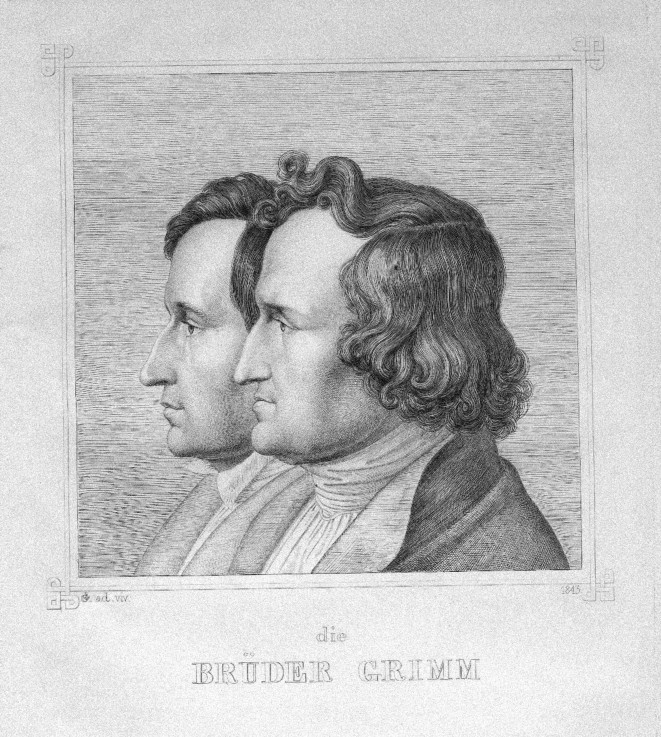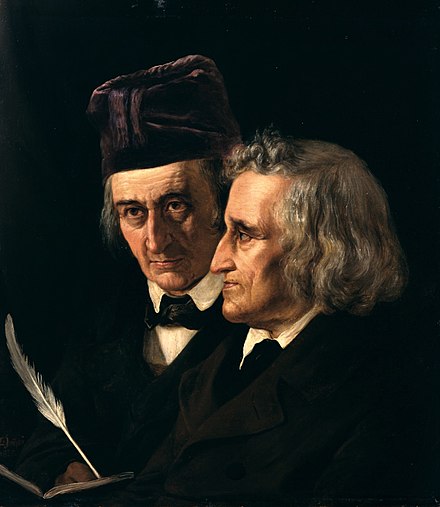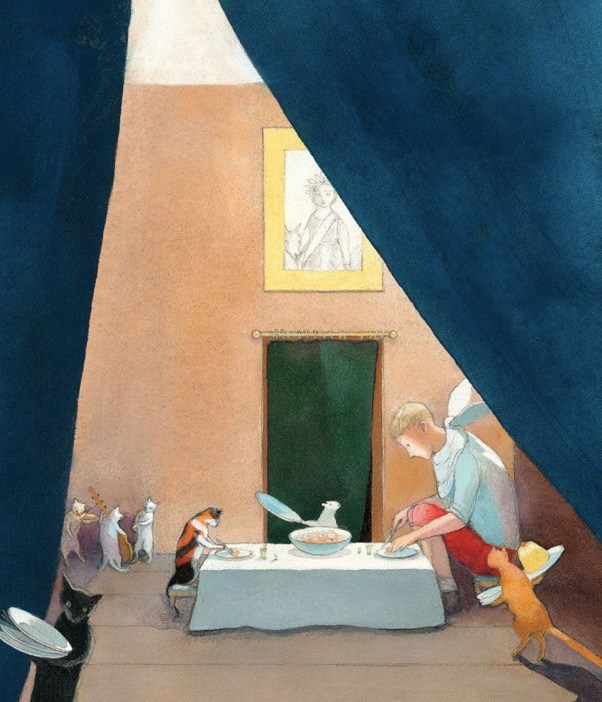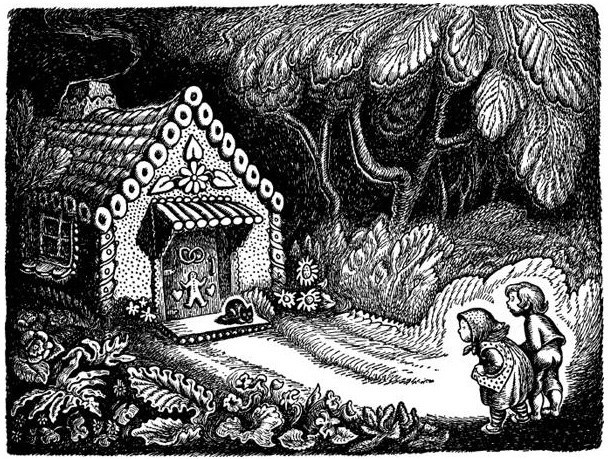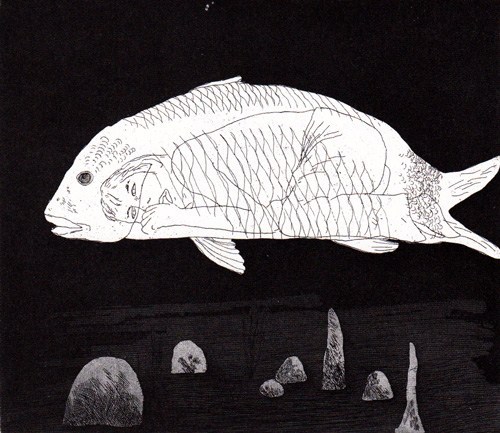Jacob Ludwig Karl Grimm (1785-1863) and Wilhelm Carl Grimm (1786-1859), better known as Brothers Grimm, were born in Hanau, Germany to stay at home mother, Dorothea Grimm nee Zimmer, and lawyer and jurist father, Philipp Wilhelm Grimm. Philipp’s death in 1796 plummeted the family into poverty, and, being the eldest surviving siblings-3 Grimm children had passed away as infants-the brothers assumed responsibility for the household. Favouritism towards higher born students was evident throughout the boys’ childhood education, and yet each graduated head of his class due to unwavering academic dedication. University was no different; they had to request to study law, were excluded from applying for financial aid, and couldn’t afford to participate in student activities. After a lifetime of study, Jacob Grimm and Wilhelm Grimm became two of the most important German scholars of their time. Collectively, they held the titles of author, editor, librarian, German studies professor, philologist, folklorist, and lexicographer.
German studies: The field of humanities that researches, documents, and disseminates German language and literature in both its historic and present forms. (1)
Philology: The study of literary texts as well as oral and written records, the establishment of their authenticity and their original form, and the determination of their meaning. (2)
Lexicography: The art or craft of compiling, writing and editing dictionaries.(3)
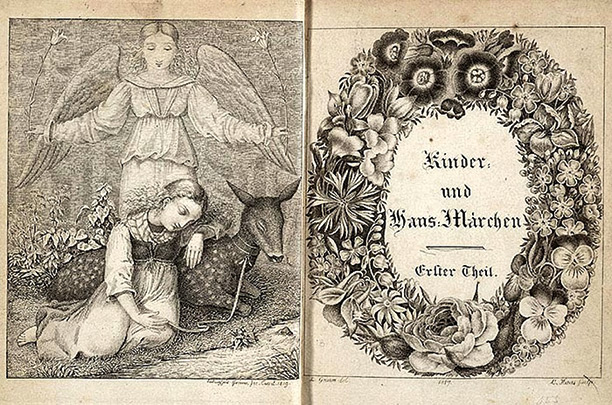
As librarians, the Brothers Grimm had low income but were content with the amount of time they had for research in the position. They had basically dropped their pursuit at becoming lawyers, like their late father was, and instead dedicated themselves to literature. They didn’t write any of the tales, as people often believe, but collected the mostly orally sourced tales into two volumes, the first editions being published in 1812, as Kinder- und Hausmärchen–Children and household tales, or more commonly known as Grimms’ Fairy Tale. Public school had recently been made compulsory in Europe, so there were more literate middle-class people reading, and their books spread like wildfire. The books were commercially successful, but the violence and sexual content made them less well-received than they would have been sans explicit material. Families were interested in having a more child-friendly version of Grimms’ Fairy Tale, so they started sending in their versions of the published tales. This gave the brothers plenty of material for the revised second edition, published in 1819. The 7th edition of Grimms’ Fairy Tale, published in 1857, is the one most people refer to for retelling and translating. You can read the original 200 tales and ten legends, as translated by Margaret Hunt in 1884, at the website World of Tales, through this link: https://www.worldoftales.com/fairy_tales/Grimm_fairy_tales_Margaret_Hunt.html#gsc.tab=0. A prime example that displays the violent stories that were cut is How Some Children Played At Slaughtering, and you can read it below. This story has been collected from two sources, and each was copied from the website for Children and Youth in History.
How Some Children Played At Slaughtering
I
In a city named Franecker, located in West Friesland, some young boys and girls between the ages of five and six happened to be playing with one another. They chose one boy to play a butcher, another boy to play was to be a cook, and a third boy was to be a pig. Then they chose one girl to be a cook and another girl her assistant. The assistant was to catch the blood of the pig in a little bowl so they could make sausages. As agreed, the butcher now fell upon the little boy playing the pig, threw him to the ground, and slit his throat open with a knife, while the assistant cook caught the blood in her little bowl. A councilman was walking nearby and saw this wretched act. He immediately took the butcher with him and led him into the house of the mayor, who instantly summoned the entire council. They deliberated about this incident and did not know what they should do to the boy, for they realized it had all been part of a children’s game. One of the councilmen, an old wise man, advised the chief judge to take a beautiful red apple in one hand and a Rhenish gulden in the other. Then he was to call the boy and stretch out his hands to him. If the boy took the apple, he was to be set free. If he took the gulden, he was to be killed. The judge took the wise man’s advice, and the boy grabbed the apple with a laugh. Thus he was set free without any punishment.II
There once was a father who slaughtered a pig, and his children saw that. In the afternoon, when they began playing, one child said to the other, “you be the little pig, and I’ll be the butcher.” He then took a shiny knife and slit his little brother’s throat. Their mother was upstairs in a room bathing another child, and when she heard the cries of her son, she immediately ran downstairs. Upon seeing what had happened, she took the knife out of her son’s throat and was so enraged that she stabbed the heart of the other boy, who had been playing the butcher. Then she quickly ran back to the room to tend to her child in the bathtub, but while she was gone, he had drowned in the tub. Now the woman became so frightened and desperate that she did not allow the neighbors to comfort her and finally hung herself. When her husband came back from the fields and saw everything, he became so despondent that he died soon after.
Fairy tales evolve over time to represent the current culture. Both a form of education and entertainment, they’re often used to teach children moral lessons. The oldest known tale is ~6000 years old. Verbal and pictorial depictions of Grimms’ collected tales have evolved drastically throughout the centuries, and different renditions can be viewed below. The Grimm Brothers made a significant impact in the world of German literature and linguistics and triggered the professional study of folklore. A large number of our favourite Disney movies and shorts, including, but not limited to, Sleeping Beauty (originally Briar Rose), Cinderella, Snow White, Rapunzel, and The Frog Princess (originally The Frog Prince), are based on Grimm’s tales.
Image Citations:
https://www.reprodart.com/kunst/ludwig_emil_grimm/jacob_und_wilhelm_grimm.jpg
https://upload.wikimedia.org/wikipedia/commons/f/ff/Grimm.jpg
https://www.historytoday.com/sites/default/files/grimm.jpg
https://www.brainpickings.org/2015/07/20/best-brothers-grimm-illustrations/
Information Citations:
https://en.wikipedia.org/wiki/Brothers_Grimm
https://www.worldoftales.com/fairy_tales/Grimm_fairy_tales_Margaret_Hunt.html#gsc.tab=0
(1) https://en.wikipedia.org/wiki/German_studies
(2) https://en.wikipedia.org/wiki/Philology
(3) https://en.wikipedia.org/wiki/Lexicography
https://chnm.gmu.edu/cyh/primary-sources/113

